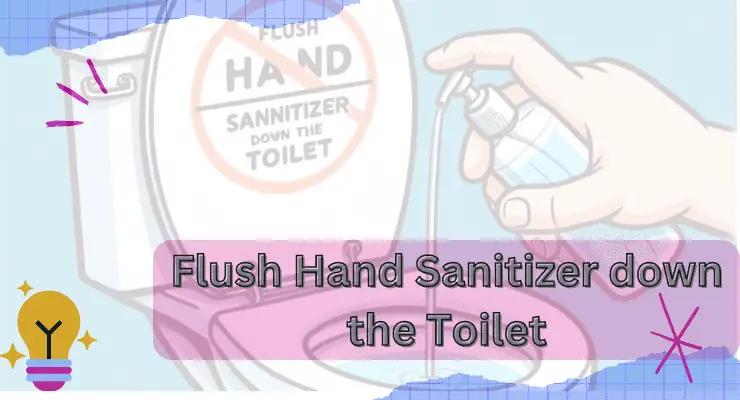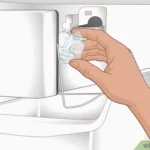Do not flush hand sanitizer down the toilet. It can cause plumbing issues and environmental harm.
Hand sanitizer has become a household staple, especially during health crises. Many people wonder about its proper disposal. Flushing hand sanitizer down the toilet might seem convenient but poses significant risks. The chemicals can disrupt plumbing systems and contaminate water supplies.
Improper disposal can also harm aquatic life and ecosystems. Instead, consider safer alternatives such as disposing of it in household hazardous waste collection programs. Proper disposal protects both your plumbing and the environment. Always read the product label for specific disposal instructions. Making informed choices can significantly reduce environmental impact and keep your home systems functioning efficiently.

Environmental Impact
Flushing hand sanitizer down the toilet can harm the environment. It leads to water contamination and soil pollution. Understanding these impacts helps protect our planet.
Water Contamination
Hand sanitizer contains chemicals. These chemicals can mix with water sources. This can make water unsafe for drinking and wildlife. The chemicals disrupt aquatic life and ecosystems.
- Alcohols like ethanol and isopropanol are harmful.
- Fragrances and dyes can be toxic.
- Water treatment plants struggle to remove these chemicals.
Even small amounts can cause big problems. Clean water is essential for all life forms.
Soil Pollution
Flushing hand sanitizer can also lead to soil pollution. Chemicals seep into the ground, affecting soil quality. This can harm plants and animals living in the soil.
- Plants absorb harmful chemicals.
- Animals eat contaminated plants and suffer health issues.
- Soil loses its natural nutrients.
Healthy soil is crucial for growing food and maintaining ecosystems. Protecting soil means protecting our future.
Chemical Composition
Understanding the chemical composition of hand sanitizers is crucial. It helps us know why they shouldn’t be flushed. This section dives into the active ingredients and potential hazards.
Active Ingredients
Hand sanitizers typically contain alcohol as the main ingredient. This is often in the form of ethanol or isopropanol. These alcohols kill germs effectively. But they are not safe for your plumbing system.
- Ethanol (60-95%): It is highly flammable and evaporates quickly.
- Isopropanol (70-100%): Also flammable and can be toxic in large amounts.
Besides alcohol, hand sanitizers may have other ingredients. These include water, fragrances, and moisturizing agents. These substances can cause blockages in pipes.
Potential Hazards
Flushing hand sanitizer down the toilet poses several risks. Here are some key hazards:
| Hazard | Description |
|---|---|
| Plumbing Damage | Alcohols can corrode pipes and fittings. |
| Environmental Impact | Harmful chemicals can enter water systems. |
| Flammability | Alcohol in sanitizers is highly flammable. |
These hazards highlight the need for proper disposal. Never flush hand sanitizers down the toilet.
Water Treatment Challenges
Flushing hand sanitizer down the toilet can cause serious water treatment challenges. Water treatment plants work hard to keep our water clean. Hand sanitizers contain chemicals that complicate this process. Below, we explore two major issues: Filtration Issues and Chemical Breakdown.
Filtration Issues
Water treatment plants use filters to remove harmful substances. Hand sanitizer contains particles that clog these filters. Clogged filters slow down the water treatment process. This makes it hard to clean the water effectively. Some filters can’t remove tiny particles from hand sanitizer. This means the water remains polluted.
Chemical Breakdown
The chemicals in hand sanitizer don’t break down easily. Water treatment plants use special bacteria to clean water. These bacteria can’t break down sanitizer chemicals. This makes the cleaning process less effective. Some chemicals in hand sanitizers are harmful to these bacteria. This reduces the overall efficiency of the water treatment.
Here’s a summary table of the challenges:
| Challenge | Impact |
|---|---|
| Filtration Issues | Clogs filters, slows down process |
| Chemical Breakdown | Harms cleaning bacteria, reduces efficiency |
Effects On Marine Life
Flushing hand sanitizer down the toilet harms marine life. This practice releases harmful chemicals into the waterways. These chemicals affect the delicate ecosystems in the ocean.
Toxicity Levels
Hand sanitizers contain ingredients like alcohol and triclosan. These substances are toxic to aquatic organisms. Fish and other marine species can suffer from these toxins. Even low concentrations can be harmful.
| Substance | Toxicity Level |
|---|---|
| Alcohol | High |
| Triclosan | Moderate |
| Fragrances | Low to Moderate |
Different substances in hand sanitizers have varying toxicity levels. Alcohol has a high toxicity level. Triclosan has a moderate toxicity level. Fragrances can vary from low to moderate.
Bioaccumulation
Bioaccumulation happens when toxins build up in organisms. Marine species absorb these harmful chemicals over time. This process affects the entire food chain.
- Small fish absorb toxins from the water.
- Larger fish eat the smaller fish and absorb more toxins.
- Predators like sharks and dolphins get the highest toxin levels.
Bioaccumulation poses a threat to marine life. Predators at the top of the food chain suffer the most. This can lead to decreased populations and disrupted ecosystems.
Human Health Concerns
Flushing hand sanitizer down the toilet can cause serious human health concerns. This practice impacts both drinking water safety and long-term exposure to harmful chemicals.
Drinking Water Safety
Hand sanitizers contain chemicals like alcohol and triclosan. These chemicals can enter water systems and reach our drinking water. Contaminated drinking water can cause health issues, such as stomach aches and nausea.
Table: Common Chemicals in Hand Sanitizers and Their Effects on Health
| Chemical | Health Effect |
|---|---|
| Alcohol | Dehydration, stomach issues |
| Triclosan | Hormone disruption |
Long-term Exposure
Long-term exposure to hand sanitizer chemicals can harm our bodies. These chemicals can build up in the body over time. This can lead to serious issues like hormone imbalance and weakened immune systems.
- Hormone disruption can affect growth and development.
- Weak immune systems make you more prone to infections.
To avoid these health risks, dispose of hand sanitizer properly. Do not flush it down the toilet.
Waste Management Solutions
Proper waste management helps keep our environment clean. It also prevents pollution. One common concern is how to dispose of hand sanitizer. Many people wonder if they can flush it down the toilet.
Proper Disposal Methods
Flushing hand sanitizer down the toilet is not safe. It harms our water systems. Instead, use these proper disposal methods:
- Check local waste disposal guidelines.
- Take it to a hazardous waste facility.
- Mix it with cat litter before throwing in the trash.
These methods ensure safe disposal. They also protect our environment.
Recycling Options
Recycling is another good option. But can you recycle hand sanitizer? The answer depends on its container:
| Container Type | Recycling Instructions |
|---|---|
| Plastic Bottles | Rinse and place in recycling bin. |
| Glass Bottles | Rinse and place in glass recycling. |
| Pumps | Dispose in regular trash. |
Recycling these containers helps reduce waste. Always follow local recycling rules.
Government Regulations
Government regulations play a critical role in managing waste disposal. This includes guidelines on how to dispose of items like hand sanitizer. Improper disposal can harm the environment and plumbing systems. Understanding these regulations helps in making informed decisions.
Current Laws
Various countries have set strict rules on disposing of chemicals. Hand sanitizers often contain alcohol and other substances. These can be harmful to the environment. Disposing of them in the toilet may violate local laws.
- Environmental Protection Agencies: Many countries have agencies that oversee waste disposal.
- Local Ordinances: Some cities have specific rules for disposing of hand sanitizers.
- Plumbing Codes: Improper disposal can damage plumbing systems.
Breaking these laws can result in fines or penalties. It’s crucial to follow local guidelines to avoid these consequences.
Future Policies
Governments are working on updating waste disposal policies. These policies aim to better protect the environment. New guidelines may include stricter controls on chemical disposal.
- More Stringent Regulations: Expect tighter rules on disposing of hand sanitizers.
- Public Awareness Campaigns: Governments may launch campaigns to educate the public.
- Eco-Friendly Alternatives: Encouragement to use more biodegradable options.
Future policies will likely focus on reducing environmental impact. Staying informed helps in complying with these new regulations.
Public Awareness
Raising public awareness about the dangers of flushing hand sanitizer down the toilet is crucial. Many people do not realize the environmental impact it causes. Efforts must be made to educate the community and involve them in proper disposal methods.
Educational Campaigns
Educational campaigns can help spread important information about proper disposal. Schools, businesses, and community centers can host workshops and seminars. These events can teach people why they should not flush hand sanitizer.
- Distribute brochures with clear guidelines.
- Use social media to reach a wider audience.
- Create informative videos explaining the consequences.
Partnering with local news outlets can also amplify the message. By broadcasting these educational materials, the community will be better informed.
Community Involvement
Community involvement is key to changing behaviors. Organize neighborhood clean-up events and involve local leaders. These events can highlight the importance of proper waste disposal.
| Action | Benefit |
|---|---|
| Neighborhood workshops | Increases local awareness |
| Clean-up drives | Showcases immediate impact |
| Involving schools | Educates the next generation |
Encouraging community members to share their knowledge can create a ripple effect. The more people talk about it, the more widespread the awareness will be.
Frequently Asked Questions
What Happens If You Flush Hand Sanitizer Down The Toilet?
Flushing hand sanitizer can damage plumbing and harm the environment. It disrupts septic systems and contaminates water sources. Dispose of properly.
How Do You Dispose Of Expired Hand Sanitizer?
Dispose of expired hand sanitizer by taking it to a hazardous waste facility. Alternatively, you can dilute it with water and pour it down the drain. Ensure the container is empty before recycling.
Can I Use Hand Sanitizer On Toilet?
Yes, you can use hand sanitizer on toilet surfaces. It kills germs but may not remove dirt.
What Removes Hand Sanitizer?
Hand sanitizer can be removed with soap and water. Rub your hands thoroughly and rinse well.
Can You Flush Hand Sanitizer Down The Toilet?
No, flushing hand sanitizer can harm plumbing and pollute water systems.
Conclusion
Flushing hand sanitizer down the toilet can harm plumbing and the environment. It’s better to dispose of it properly. Always check local guidelines for safe disposal methods. Protect your home and the ecosystem by making responsible choices. Let’s keep our water systems clean and safe for everyone.





